height Alfa Romeo Giulietta 2017 Owner's Manual
[x] Cancel search | Manufacturer: ALFA ROMEO, Model Year: 2017, Model line: Giulietta, Model: Alfa Romeo Giulietta 2017Pages: 212, PDF Size: 4.56 MB
Page 15 of 212
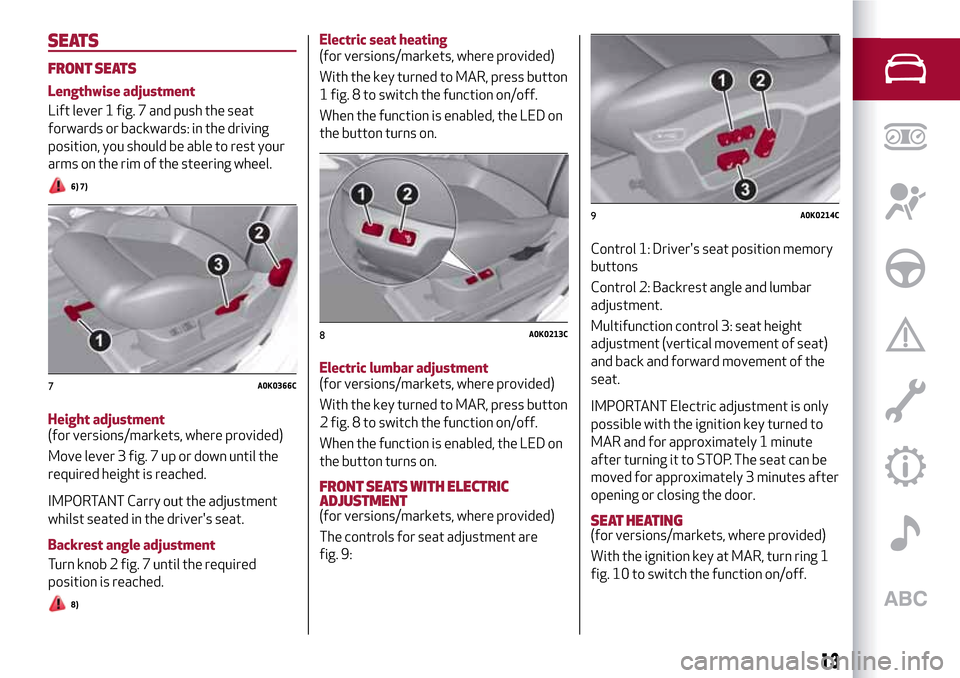
SEATS
FRONT SEATS
Lengthwise adjustment
Lift lever 1 fig. 7 and push the seat
forwards or backwards: in the driving
position, you should be able to rest your
arms on the rim of the steering wheel.
6) 7)
Height adjustment
(for versions/markets, where provided)
Move lever 3 fig. 7 up or down until the
required height is reached.
IMPORTANT Carry out the adjustment
whilst seated in the driver's seat.
Backrest angle adjustment
Turn knob 2 fig. 7 until the required
position is reached.
8)
Electric seat heating
(for versions/markets, where provided)
With the key turned to MAR, press button
1 fig. 8 to switch the function on/off.
When the function is enabled, the LED on
the button turns on.
Electric lumbar adjustment
(for versions/markets, where provided)
With the key turned to MAR, press button
2 fig. 8 to switch the function on/off.
When the function is enabled, the LED on
the button turns on.
FRONT SEATS WITH ELECTRIC
ADJUSTMENT
(for versions/markets, where provided)
The controls for seat adjustment are
fig. 9:Control 1: Driver's seat position memory
buttons
Control 2: Backrest angle and lumbar
adjustment.
Multifunction control 3: seat height
adjustment (vertical movement of seat)
and back and forward movement of the
seat.
IMPORTANT Electric adjustment is only
possible with the ignition key turned to
MAR and for approximately 1 minute
after turning it to STOP. The seat can be
moved for approximately 3 minutes after
opening or closing the door.
SEAT HEATING
(for versions/markets, where provided)
With the ignition key at MAR, turn ring 1
fig. 10 to switch the function on/off.
7A0K0366C
8A0K0213C
9A0K0214C
13
Page 16 of 212
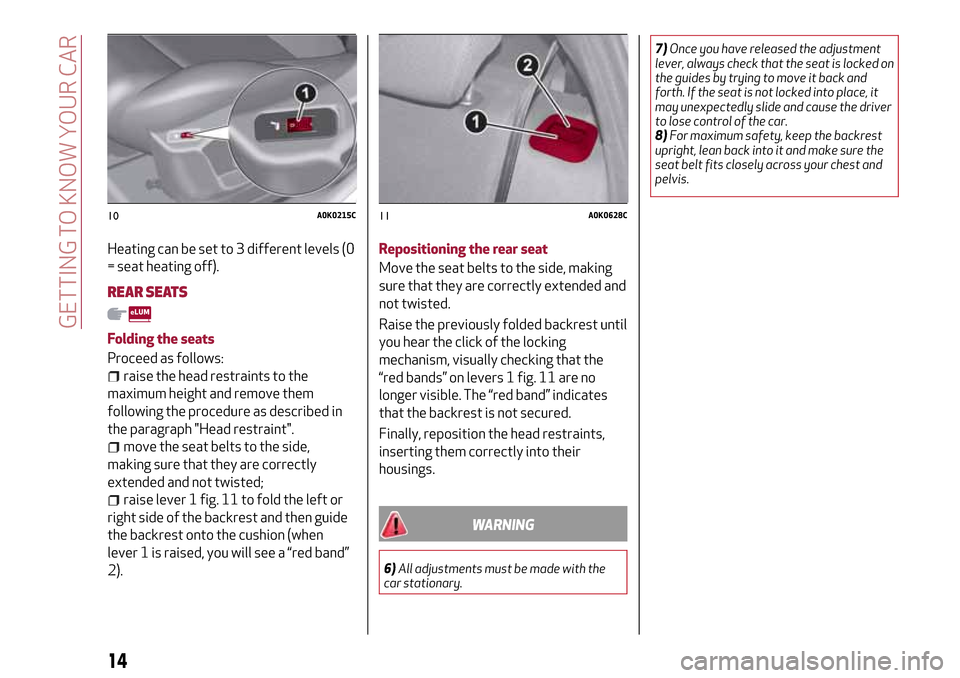
Heating can be set to 3 different levels (0
= seat heating off).
REAR SEATS
Folding the seats
Proceed as follows:
raise the head restraints to the
maximum height and remove them
following the procedure as described in
the paragraph "Head restraint".
move the seat belts to the side,
making sure that they are correctly
extended and not twisted;
raise lever 1 fig. 11 to fold the left or
right side of the backrest and then guide
the backrest onto the cushion (when
lever 1 is raised, you will see a “red band”
2).Repositioning the rear seat
Move the seat belts to the side, making
sure that they are correctly extended and
not twisted.
Raise the previously folded backrest until
you hear the click of the locking
mechanism, visually checking that the
“red bands” on levers 1 fig. 11 are no
longer visible. The “red band” indicates
that the backrest is not secured.
Finally, reposition the head restraints,
inserting them correctly into their
housings.
WARNING
6)All adjustments must be made with the
car stationary.7)Once you have released the adjustment
lever, always check that the seat is locked on
the guides by trying to move it back and
forth. If the seat is not locked into place, it
may unexpectedly slide and cause the driver
to lose control of the car.
8)For maximum safety, keep the backrest
upright, lean back into it and make sure the
seat belt fits closely across your chest and
pelvis.
10A0K0215C11A0K0628C
14
GETTING TO KNOW YOUR CAR
Page 17 of 212
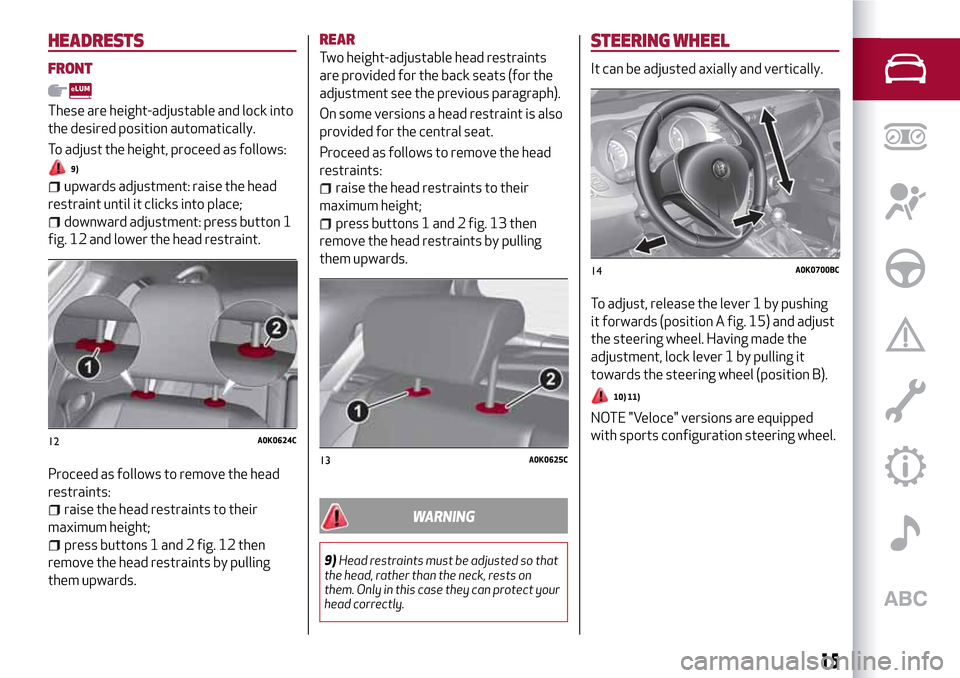
HEADRESTS
FRONT
These are height-adjustable and lock into
the desired position automatically.
To adjust the height, proceed as follows:
9)
upwards adjustment: raise the head
restraint until it clicks into place;
downward adjustment: press button 1
fig. 12 and lower the head restraint.
Proceed as follows to remove the head
restraints:
raise the head restraints to their
maximum height;
press buttons 1 and 2 fig. 12 then
remove the head restraints by pulling
them upwards.
REAR
Two height-adjustable head restraints
are provided for the back seats (for the
adjustment see the previous paragraph).
On some versions a head restraint is also
provided for the central seat.
Proceed as follows to remove the head
restraints:
raise the head restraints to their
maximum height;
press buttons 1 and 2 fig. 13 then
remove the head restraints by pulling
them upwards.
WARNING
9)Head restraints must be adjusted so that
the head, rather than the neck, rests on
them. Only in this case they can protect your
head correctly.
STEERING WHEEL
It can be adjusted axially and vertically.
To adjust, release the lever 1 by pushing
it forwards (position A fig. 15) and adjust
the steering wheel. Having made the
adjustment, lock lever 1 by pulling it
towards the steering wheel (position B).
10) 11)
NOTE "Veloce" versions are equipped
with sports configuration steering wheel.
12A0K0624C
13A0K0625C
14A0K0700BC
15
Page 70 of 212
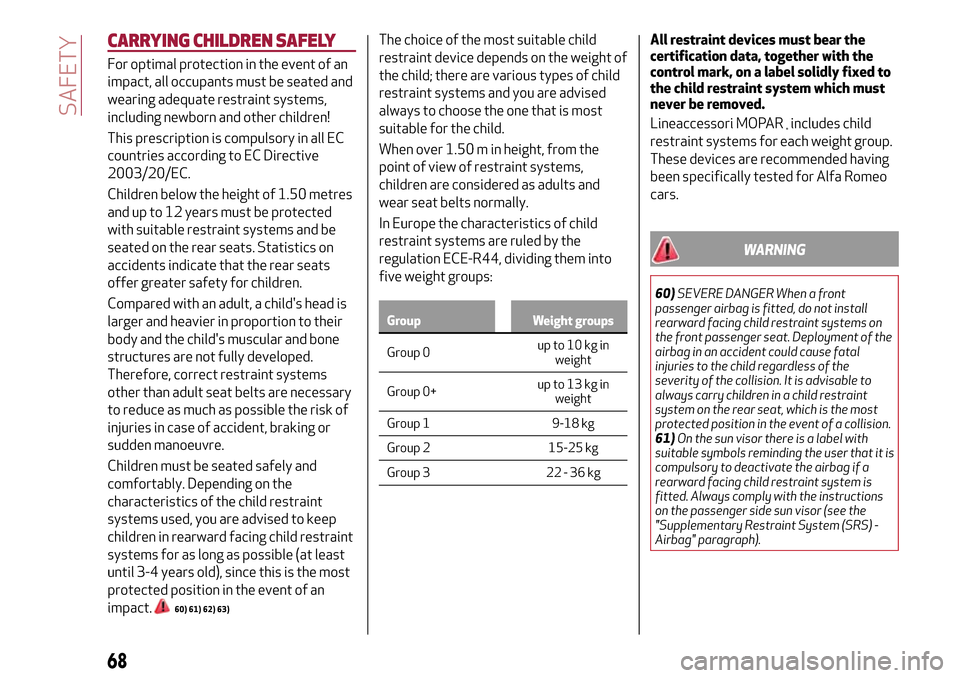
CARRYING CHILDREN SAFELY
For optimal protection in the event of an
impact, all occupants must be seated and
wearing adequate restraint systems,
including newborn and other children!
This prescription is compulsory in all EC
countries according to EC Directive
2003/20/EC.
Children below the height of 1.50 metres
and up to 12 years must be protected
with suitable restraint systems and be
seated on the rear seats. Statistics on
accidents indicate that the rear seats
offer greater safety for children.
Compared with an adult, a child's head is
larger and heavier in proportion to their
body and the child's muscular and bone
structures are not fully developed.
Therefore, correct restraint systems
other than adult seat belts are necessary
to reduce as much as possible the risk of
injuries in case of accident, braking or
sudden manoeuvre.
Children must be seated safely and
comfortably. Depending on the
characteristics of the child restraint
systems used, you are advised to keep
children in rearward facing child restraint
systems for as long as possible (at least
until 3-4 years old), since this is the most
protected position in the event of an
impact.
60) 61) 62) 63)
The choice of the most suitable child
restraint device depends on the weight of
the child; there are various types of child
restraint systems and you are advised
always to choose the one that is most
suitable for the child.
When over 1.50 m in height, from the
point of view of restraint systems,
children are considered as adults and
wear seat belts normally.
In Europe the characteristics of child
restraint systems are ruled by the
regulation ECE-R44, dividing them into
five weight groups:
Group Weight groups
Group 0upto 10 kg in
weight
Group 0+up to 13 kg in
weight
Group 1 9-18 kg
Group 2 15-25 kg
Group 3 22 - 36 kg
All restraint devices must bear the
certification data, together with the
control mark, on a label solidly fixed to
the child restraint system which must
never be removed.
Lineaccessori MOPAR
®includes child
restraint systems for each weight group.
These devices are recommended having
been specifically tested for Alfa Romeo
cars.
WARNING
60)SEVERE DANGER When a front
passenger airbag is fitted, do not install
rearward facing child restraint systems on
the front passenger seat. Deployment of the
airbag in an accident could cause fatal
injuries to the child regardless of the
severity of the collision. It is advisable to
always carry children in a child restraint
system on the rear seat, which is the most
protected position in the event of a collision.
61)On the sun visor there is a label with
suitable symbols reminding the user that it is
compulsory to deactivate the airbag if a
rearward facing child restraint system is
fitted. Always comply with the instructions
on the passenger side sun visor (see the
"Supplementary Restraint System (SRS) -
Airbag" paragraph).
68
SAFETY
Page 72 of 212

GROUP 2
65) 66) 67) 68) 69)
Children from 15 to 25 kg may be
restrained directly by the car seat belts
fig. 50.
In this case, the child restraint system is
used to position the child correctly with
respect to the seat belts so that the
diagonal belt section crosses the child’s
chest and not the neck, and the lower part
is snug on the pelvis not the abdomen.
GROUP 3
65) 66) 67) 68) 69)
For children between 22 kg and 36 kg,
there are dedicated restraint systems
that allow the seat belt to be worn
correctly.
The fig. 51 shows the correct child
positioning on the rear seat.
Children over 1.50 m in height can wear
seat belts like adults.
50A0K0016C
51A0K0017C
70
SAFETY
Page 73 of 212
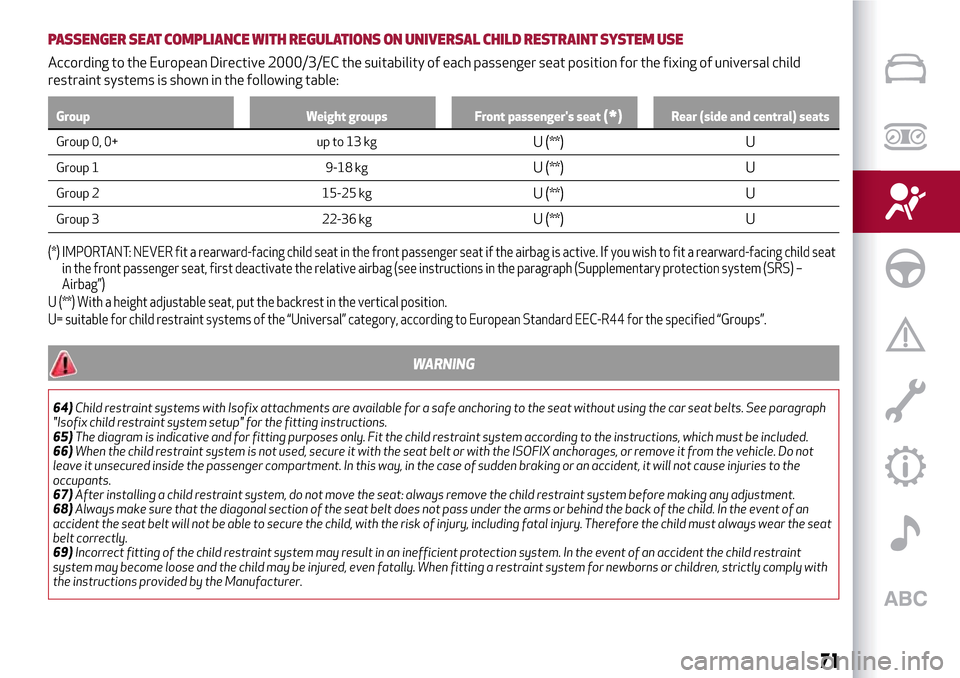
PASSENGER SEAT COMPLIANCE WITH REGULATIONS ON UNIVERSAL CHILD RESTRAINTSYSTEM USE
According to the European Directive 2000/3/EC the suitability of each passenger seat position for the fixing of universal child
restraint systems is shown in the following table:
Group Weight groups Front passenger's seat(*)Rear (side and central) seats
Group 0, 0+ up to 13 kgU (**) U
Group 1 9-18 kgU (**) U
Group 2 15-25 kgU (**) U
Group 3 22-36 kgU (**) U
(*) IMPORTANT: NEVER fit a rearward-facing child seat in the front passenger seat if the airbag is active. If you wish to fit a rearward-facing child seat
in the front passenger seat, first deactivate the relative airbag (see instructions in the paragraph (Supplementary protection system (SRS) –
Airbag”)
U (**) With a height adjustable seat, put the backrest in the vertical position.
U= suitable for child restraint systems of the “Universal” category, according to European Standard EEC-R44 for the specified “Groups”.
WARNING
64)Child restraint systems with Isofix attachments are available for a safe anchoring to the seat without using the car seat belts. See paragraph
"Isofix child restraint system setup" for the fitting instructions.
65)The diagram is indicative and for fitting purposes only. Fit the child restraint system according to the instructions, which must be included.
66)When the child restraint system is not used, secure it with the seat belt or with the ISOFIX anchorages, or remove it from the vehicle. Do not
leave it unsecured inside the passenger compartment. In this way, in the case of sudden braking or an accident, it will not cause injuries to the
occupants.
67)After installing a child restraint system, do not move the seat: always remove the child restraint system before making any adjustment.
68)Always make sure that the diagonal section of the seat belt does not pass under the arms or behind the back of the child. In the event of an
accident the seat belt will not be able to secure the child, with the risk of injury, including fatal injury. Therefore the child must always wear the seat
belt correctly.
69)Incorrect fitting of the child restraint system may result in an inefficient protection system. In the event of an accident the child restraint
system may become loose and the child may be injured, even fatally. When fitting a restraint system for newborns or children, strictly comply with
the instructions provided by the Manufacturer.
71
Page 156 of 212
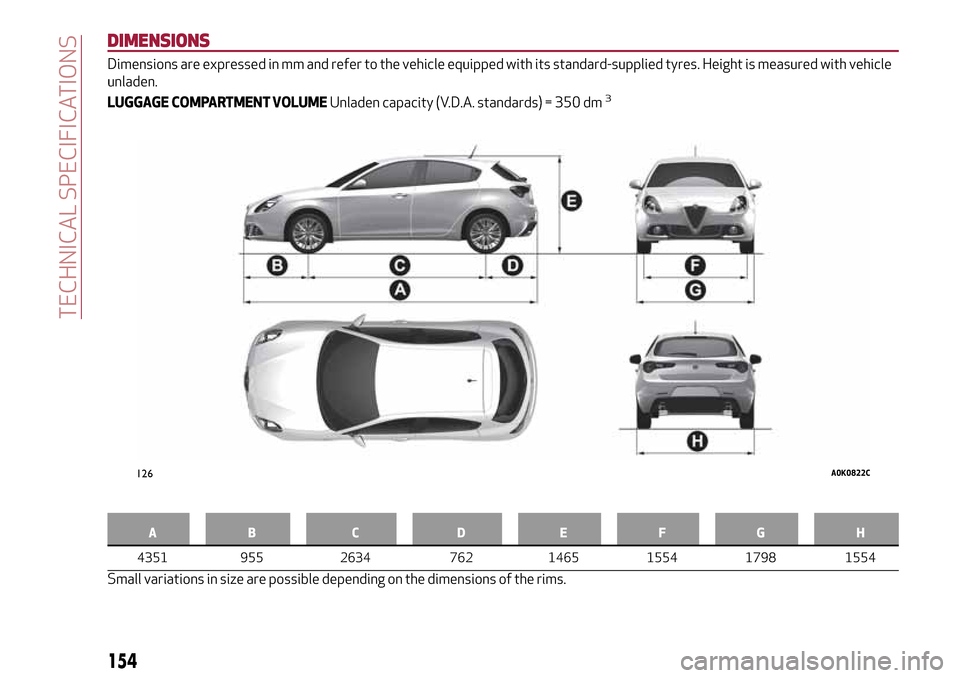
DIMENSIONS
Dimensions are expressed in mm and refer to the vehicle equipped with its standard-supplied tyres. Height is measured with vehicle
unladen.
LUGGAGE COMPARTMENT VOLUMEUnladen capacity (V.D.A. standards) = 350 dm
3
AB C D EFGH
4351 955 2634 762 1465 1554 1798 1554
Small variations in size are possible depending on the dimensions of the rims.
126A0K0822C
154
TECHNICAL SPECIFICATIONS